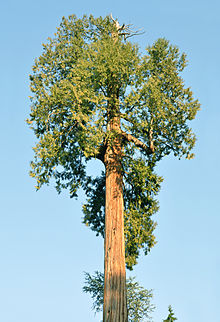
Back عفص مطوي Arabic عفص مطوى ARZ Nəhəng tuya Azerbaijani Туя гіганцкая Byelorussian Thuja plicata Bulgarian Thuja plicata CEB Zerav obrovský Czech Cedrwydden goch Welsh Kæmpethuja Danish Riesen-Lebensbaum German
| Thuja plicata | |
|---|---|

| |
| An old tree in Vancouver | |
| Scientific classification | |
| Kingdom: | Plantae |
| Clade: | Tracheophytes |
| Clade: | Gymnospermae |
| Division: | Pinophyta |
| Class: | Pinopsida |
| Order: | Cupressales |
| Family: | Cupressaceae |
| Genus: | Thuja |
| Species: | T. plicata
|
| Binomial name | |
| Thuja plicata | |

| |
| Range of T. plicata in the Pacific Northwest | |
Thuja plicata is a large evergreen coniferous tree in the family Cupressaceae, native to the Pacific Northwest of North America. Its common name is western redcedar in the U.S.[2] or western red cedar in the UK,[3] and it is also called pacific red cedar, giant arborvitae, western arborvitae, just cedar, giant cedar, or shinglewood.[4] It is not a true cedar of the genus Cedrus. T. plicata is the largest species in the genus Thuja, growing up to 70 metres (230 ft) tall and 7 m (23 ft) in diameter. It mostly grows in areas that experience a mild climate with plentiful rainfall, although it is sometimes present in drier areas on sites where water is available year-round, such as wet valley bottoms and mountain streamsides. The species is shade-tolerant and able to establish in forest understories and is thus considered a climax species. It is a very long-lived tree, with some specimens reaching ages of well over 1,000 years.
Indigenous peoples of the Pacific Northwest use the wood of this species for many purposes, such as building canoes, totem poles, and tools. The bark is harvested by indigenous peoples and processed into a fiber, which they use to make items such as rope, baskets, clothing, and rain hats. Because of its wide range of uses, the species is of great cultural importance to these people. Western redcedar wood is aromatic and rot-resistant and is used for applications such as the construction of shingles and siding. It has been introduced to cool temperate areas in other parts of the world, such as Northern Europe and New Zealand.
- ^ Farjon, A. (2013). "Thuja plicata". IUCN Red List of Threatened Species. 2013: e.T42263A2968155. doi:10.2305/IUCN.UK.2013-1.RLTS.T42263A2968155.en.
- ^ USDA, NRCS (n.d.). "Thuja plicata". The PLANTS Database (plants.usda.gov). Greensboro, North Carolina: National Plant Data Team. Retrieved 10 December 2015.
- ^ "Thuja plicata". Royal Horticultural Society (RHS). Archived from the original on 2 August 2021. Retrieved 7 September 2021.
- ^ "Thuja plicata". Germplasm Resources Information Network. Agricultural Research Service, United States Department of Agriculture. Retrieved 11 December 2017.
© MMXXIII Rich X Search. We shall prevail. All rights reserved. Rich X Search
